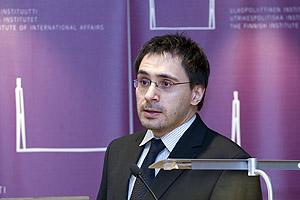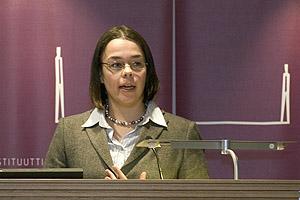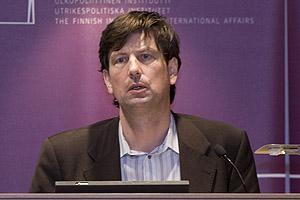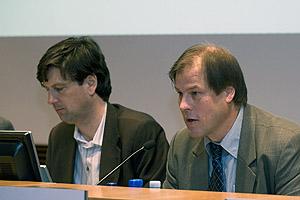The December 2009 United Nations climate change conference in Copenhagen has been set as the political deadline for establishing a comprehensive regime to follow up on the Kyoto Protocol. In order to succeed in mitigating dangerous climate change the next regime must facilitate actions limiting emissions not only in industrialised countries, but also in the major emerging economies. However, as a result of varying levels of development and divergent views concerning the dynamics of economic growth, the world’s greatest emitters have very different approaches to global climate governance. This event outlines these major emitters’ negotiating positions on the eve of the Copenhagen summit.
Programme
Opening remarks and chair:
Mr. Jukka Uosukainen, Director, Unit of International and EU Affairs, Ministry of Environment, Finland
The Major Emitters panel:
China: Mr. Hans Verolme, Senior Strategic Climate Adviser
India: Mr. Antto Vihma, Project Researcher, Finland Futures Research Centre
Japan: Mr. Alex Luta, Research Assistant, Finnish Institute of International Affairs
Russia: Dr. Anna Korppoo, Senior Researcher, Finnish Institute of International Affairs
Saudi Arabia: Ms. Mari Luomi, Researcher, Finnish Institute of International Affairs
United States: Mr. Hans Verolme, Senior Strategic Climate Adviser
India: Mr. Antto Vihma, Project Researcher, Finland Futures Research Centre
Japan: Mr. Alex Luta, Research Assistant, Finnish Institute of International Affairs
Russia: Dr. Anna Korppoo, Senior Researcher, Finnish Institute of International Affairs
Saudi Arabia: Ms. Mari Luomi, Researcher, Finnish Institute of International Affairs
United States: Mr. Hans Verolme, Senior Strategic Climate Adviser
Discussion
Summary of the seminar
The chair, Mr. Jukka Uosukainen, Director, Unit of International and EU Affairs, Ministry of Environment, Finland, gave his opening comments and welcomed the audience to the seminar. From his own experiences as a negotiator, Mr Uosukainen reflected upon the similarities of the rush in the build up to the last moments of the Kyoto negotiations and the imminent Copenhagen conference. The chair stressed the complexities of negotiating a deal on climate change, especially producing the legal text, then moving on to touch upon some of the key questions that will have to be answered in order for an agreement to be reached in Copenhagen: will the developing countries commit themselves? Who will cover the incremental costs? How will the domestic situations within countries influence the mandate with which parties to the conference can come with? This seminar is aimed at giving some hints towards answers to these questions and as to where the consensus may lie.
Mr. Alex Luta, of the Finnish Institute of International Affairs (UPI-FIIA), gave the first presentation on the case of Japan. Mr. Luta began by displaying the emissions trends for Japan, highlighting the Japanese emissions to be both above their Kyoto target of -6% from the base year and above the base year level also. Following this, the Japanese domestic position was outlined. The August elections had seen the Democratic Party of Japan (DPJ) sweep to a resounding and seismic victory over the Liberal Democratic Party, the ruling party for the past half-century. This has resulted in a sweeping reform of the Japanese government, with the effects extending to climate policy, seeing a fundamental shift in its position. The previous government had offered a conservative pledge of -8% below 1990 levels by 2020 (announced in June), whereas now the tabled pledge stands at -25% by 2020. These targets are prospectively to be attempted through a mandatory and nationwide emission trading scheme, two carbon taxes and feed-in tariffs for all forms of renewable energy.
Mr Luta moved on to say that, whilst the targets must be considered very ambitious, the pledge is conditional. Japan feels somewhat betrayed by the US’ failure to ratify the Kyoto Protocol, and also strongly feels that the neighbour and rival China, and the wider regional power of India must also make commitments, at least in terms of carbon or energy intensity, before Japan will enter into a binding agreement. Also, any targets set for and by China and India must be internationally measurable, reportable and verifiable. Japan’s position for Copenhagen also sees a preference for a new legal instrument.
Points of negotiation and vested interest for Japan at Copenhagen will be to secure the continued use of the Clean Development Mechanism and Joint Implementation mechanism to offset industrial emissions, and to retain its very generous ceiling on the amount of outsets it can get from taking into account carbon sinks. At the same time, Prime Minister Hatoyama’s initiative will see significant amounts of money and technology brought to the negotiating table. The presentation was rounded off by stressing that the Japanese pledge not only represents a major shift in policy, but is also extraordinary in itself. The rhetorical language coming from Japan overlaps in a large extent with the EU, and closer cooperation in negotiations between these two parties could lead to unexpected benefits. However, the participation and commitment of the US, China and India is integral to the Japanese position.
Ms. Mari Luomi, an expert on the Middle East from UPI-FIIA, outlined the Saudi Arabian position for Copenhagen in her presentation titled: ‘Obstructionist Oil Giant or Fearful Fossil?’. Firstly, as part of the G77 negotiating group, which contains and represents 130 developing countries, not only does Saudi Arabia’s presence immediately put into sharp relief the diversity and disunity of this negotiating block, but also easily explains criticism aimed at it over its wealth and demands: as the world’s top oil exporter and with a GDP per capita of around 19,000 US dollars, Saudi Arabia is not obviously a developing country, at least not in economic terms. However, the Kingdom of Saudi Arabia (KSA) is highly dependent on its oil revenues, faces major development challenges and is thus susceptible to changes in the consumption of oil.
The Saudi stance towards climate negotiations is thus explicated as one of long-term obstructionism. The four ‘pillars’ of the Saudi position are i) preserving oil revenues; ii) receiving compensation for the adverse impacts of response measures; iii) avoiding commitments; and iv) acquiring technology and capacity for adaptation. Beyond this, there are issues that are not directly affecting Saudi Arabia, but impinge upon the desired result of the talks, which lead to the Saudi delegations negotiating on points of NAMAs (Nationally appropriate mitigation actions), the legal framing, finance and carbon sinks. To illustrate the link between future oil revenues and the Saudi stance, Luomi points out that Saudi Arabia supports LULUCF and REDD mechanism offsets for Annex I countries, which allow industrialised countries to offset industrial emissions to some degree, thus limiting the reduction of fossil fuel use, moreover oil.
For Copenhagen, Luomi reasserts that the ‘four pillars’ above will continue to define the Saudi position, however the influence of Saudi Arabia is in decline as the major developing economies within the G77 begin to outline their own distinctive positions away from the Group. Thus, the KSA delegation will most probably rely on delaying tactics as in the past, possibly threaten smaller nations and try to block consensus.
In the future beyond COP15, the stakes for Saudi Arabia will rise, as will its anxiety. However, it is considered that, as an important ally and part of the US security constellation, the KSA should be engaged rather than isolated. Towards this, the US could tone down the oral rhetoric on oil – especially of Middle East oil – dependency, as well as fostering cooperation on Carbon Capture and Storage, capacity-building for economic diversification and on solar technology. Ultimately, however, Luomi asserts that Saudi Arabia needs to take responsibility for diversification. The KSA cannot prevent a deal, and unmitigated future may see an oil giant become a fearful fossil.
The third presentation came from Mr. Antto Vihma, project researcher at the Finland Futures Research Centre, on India and Post-2012. The only gambit of the presentation is that India is a case study of failure to build trust between the North and the South.
Vihma claims that, even if provocative, this is a fitting context for discussion of the Indian position. The tenets of the Indian position include an insistence on developed countries taking the lead in negotiations, something India feel hasn’t happened, despite the stipulation with the 1992 Convention, and, publically at least, demands a 40% reduction in developed countries’ emissions by 2020. On the topic of financing, India asks that funding, and deliverables, coming from the North has to amount to what can be considered new and additional. As with other developing countries, India maintains that such nations should not be subject to NAMAs. As for the legal aspects of the negotiations, it is possible that India does not favour a legal, ratifiable outcome from the Long term Cooperation Action (AWG-LCA) track, but binding commitments for the developed nations from the Kyoto Protocol negotiation track.
In backing its position, India points to the principle of ‘historical emissions’ from the North, and its own low per capita emissions. Based on these two ways of viewing emissions, India would not agree to the notion that it is a ‘major emitter’. Also, Vihma points out that this is not a good way in which to group countries together, given competitiveness concerns. Vihma moved on to raise the question of a possible softening of the Indian position. Though the differences between itself and China are accentuated, there is also implicit and explicit criticism of the traditional position, even as much as to – provided the ‘firewall’ between the developed and developing countries remains – be open to schedules and a registry, though the position on MRVing is unknown. In Copenhagen should China put itself forward for significant steps, India may well follow.
Next up, an overview of the Russian positionality on the road to Copenhagen was presented by Dr. Anna Korppoo, Senior Researcher at UPI-FIIA, who opened by explaining that the final position was still ‘under construction’ but most of the major pieces were in place, or a clear idea attainable. The Russian pledge is between 22-25% below 1990 levels, whilst fully intending to make the use of the carry-over of emissions surplus created by the economic collapse that came with the demise of the Soviet Union. The other key issues for Russia are the accounting rules of carbon sinks (and how much of its emissions it can offset through its vast forests), the participation of all major emitters, maintaining the status of Annex II countries and keeping the mechanisms from the Kyoto Protocol, even though the treaty itself if considered to be dead.
Russia comes to the table seeing itself something of a donor, whereby other countries can emit more as Russia hasn’t cut down trees. From some view points then, it could be considered that Russia is punished for keeping its (old) forests. However, many see the Russian forests to be over-valued under Kyoto. This came about much because Russia blocked consensus at the last minute – a trick some, including the speaker, believe it could play again in Denmark. This negotiation tactic described by Dr Korppoo she names ‘abstain-and-abduct’, which sees Russia keep its position unclear until tactically making demands at the proverbial last minute of negotiations, thus making itself both the cause and, ostentatiously, the solution to the problems. The question is, is this likely to happen in Copenhagen, and from there how can it be avoided? There is also the possibility that this unclear position is more down to a lack of a clear position rather than a tactical initiative.
Climate change is a politically marginal issue for Russia and will remain so at Copenhagen. The negotiation mandate may stay unclear, though there are make-or-break issues for the Russian delegation, namely: securing headroom for economic growth; carbon sinks and the participation of all major emitters.
In the final presentation the positions of the United States and China were delivered by Mr. Hans Verolme, a senior strategic climate adviser with over a decade of policy-related experience in both the US and Europe. Mr Verolme opened up by discussing the global realities of climate change, presenting views of the world from per capita, annual and historical emissions perspectives, before moving onto the core issues for Copenhagen. These core issues were set out as two pillars: environmental integrity, guided by the best available science, and equity. Considering the environmental side, an outcome compatible with limiting warming to “well below 2 degrees” Celsius is the target – “if you can’t change the science, change the politics” was the message. Vital to this is how much can and will the United States commit to, and at the same time, preventing the undermining of a deal through loopholes such as ‘hot air’ and non-additionality. Essentially, emissions have to peak and begin to decline within the next decade.
Equity, the second pillar, had been at the heart of negotiations and agreements from the beginning of the climate change talks. Based on the tenets of ‘Common but differentiated responsibilities’ (CBDR), securing equity in climate agreements relates to the new levels of financing for mitigation of and adaptation to climate change to be decided, with the addition of technology transfer. Considering all of the above, Mr Verolme raised the question of whether no deal would be better than a bad deal at Copenhagen.
Beyond this background, the presentation moved on to China. The position outlined was that China is to make a ‘binding’ commitment on carbon intensity, which would not be contingent on international support and to be measured, verified and reported nationally. This commitment is to reduce emissions intensity per unit GDP by 40-45% below 2005 levels by 2020. This is consistent with the IEA’s scenario of 450ppm carbon dioxide. In attaining this goal, the Communist Party has a strong-self interest. Alongside this, a renewables target for 2020 is set at 15% of energy production.
Beyond this background, the presentation moved on to China. The position outlined was that China is to make a ‘binding’ commitment on carbon intensity, which would not be contingent on international support and to be measured, verified and reported nationally. This commitment is to reduce emissions intensity per unit GDP by 40-45% below 2005 levels by 2020. This is consistent with the IEA’s scenario of 450ppm carbon dioxide. In attaining this goal, the Communist Party has a strong-self interest. Alongside this, a renewables target for 2020 is set at 15% of energy production.
Moving onto the case of the USA, the Obama administration is also ready to enter into a binding agreement, also with national MRVing. The pledge is to cut emissions by 17-20% from 2005 levels by 2020. This would only amount to a relatively meagre -4% below 1990 levels (the baseline used by most countries for pledges) and is not consistent with the 450ppm IEA scenario. The US also has the target of 15% renewable energy by 2020. Problems it will have to face in reaching these goals and in negotiations are weak car efficiency, trade measures, IPR and finance.
In conclusion, Hans Verolme expressed his doubts that Copenhagen can deliver a deal that would be compatible with what the current science dictates necessary to limit warming to 2 degrees or below. Other concerns were the asymmetry of the negotiations and the problem of securing comparability of US action whilst at the same time not jeopardising Senate ratification of the deal.
The Q&A session opened with a query on what Japan was willing to do domestically to meet its goals. Mr Luta reiterated Japanese plans for a mandatory Emissions Trading Scheme, two carbon taxes and feed-in tariffs for renewables. On the subject of Saudi Arabia, one member of audience asked for clarification of the perceived declining role of the Kingdom, and what were the Western/US interests in engaging the Saudis on climate change. Ms Luomi qualified this to mean a declining role within the context of climate change negotiations. As Brazil, South Africa, India and China (‘BASIC) countries are moving to offer their own positions rather than as part of the G77 block, the group itself – and thus Saudi Arabia as part of it – is becoming less important. Secondly, stability in the Kingdom can be seen to come from oil revenues, which, given their percentage of GDP, maintain the standard of living. If this income is removed, the state could well become unstable, jeopardising a key US security ally. Returning to Japan, Mr Luta responded to a question on the paradox of Japan offering an ambitious pledge whilst business in the state is very much against such mitigation efforts. He pointed to domestic politics and that the recent victors in the election were formed through a hatred of the party that had dominated for 50 years. The target is a u-turn and withering attack on the previous regime’s position to climate change.
Returning to Saudi issues, Ms Luomi was asked what the KSA wants from Copenhagen. She responded that the KSA are essentially seeking 4 things – no commitments; no developing country commitments; to block a deal that damages oil revenues; and clean oil technology and the funding for it.
The audience asked that since US is not part of the Kyoto Protocol, what can it bring to the table at COP15? The panel responded opining that Obama says ‘yes, we can’, but he might not say ‘yes, we will’. He understands, he will come, and will do something, but at present no-one knows what that will be or its impacts. Following on from this the panel’s Anna Korppoo asked Hans Verolme if the Chinese targets are enough for the US? In reply, he said that numbers (intensity goals) themselves are great, but it’s a political question as to whether it’s good. Some senators would want China to match US, which is impossible. Next, a Greenpeace representative enquired as to how realistic a politically binding agreement is. Mr Verolme took the opportunity to respond, highlighting that Kyoto started as COP decision that ended as a treaty. But now how to change it into a regime? Mr Verolme was positive that the world needs a new system from 2020 – one which gives incentives for action, differentiates and offers common benefits and does not create two camps. The final question put forward asked what else can US do to get the big deal comparable? The response advanced that the US administration has a battle on its hands, and cannot make long-term funding commitments unless it was written in law, which can’t happen before domestic legislation is in place.
For more on the background of the talks and the positions of the major emitters, please see the publication launched alongside the seminar ‘Towards a new climate regime?
The key players gearing up for Copenhagen’.
The key players gearing up for Copenhagen’.







